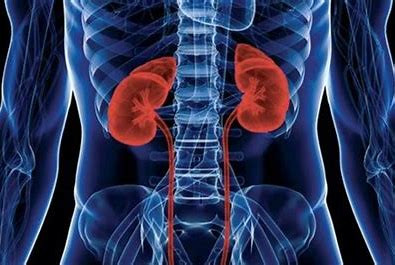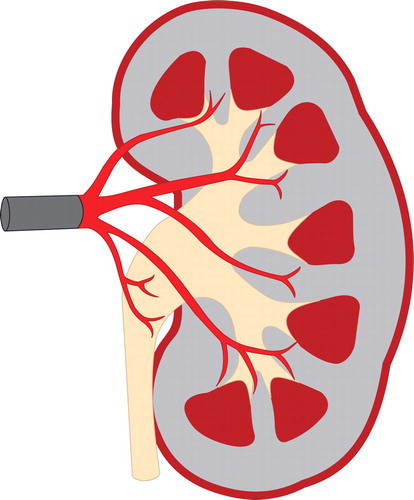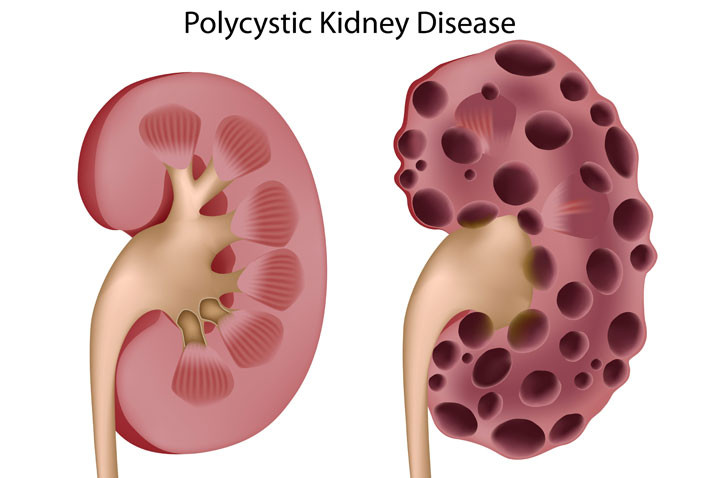Definisi
Hidronefrosis adalah kondisi pembengkakan dan pelebaran ginjal karena penumpukan urine. Penyakit ini dapat menyerang semua usia, perempuan dan laki-laki, serta dapat terjadi pada satu atau dua ginjal. Hidronefrosis juga dapat terjadi pada bayi yang masih di dalam kandungan yang disebut hidronefrosis antenatal. Hidronefrosis merupakan suatu gejala dari penyakit yang mendasari sebelumnya.
Penyebab
Hidronefrosis utamanya terjadi karena sumbatan di sistem kemih yang mengganggu aliran urine keluar dari tubuh. Sistem kemih terdiri dari ginjal, saluran ureter, kandung kemih, dan saluran uretra. Sumbatan di salah satu titik akan menyebabkan urine tidak dapat dikeluarkan tubuh atau berbalik arah kembali ke ginjal. Urine akan berkumpul di ginjal dan membuat ginjal mengalami pembesaran dan pembengkakan. Hidronefrosis lebih sering terjadi pada salah satu ginjal, tapi tidak menutup kemungkinan untuk terjadi dikeduanya.
Pada orang dewasa beberapa penyakit penyebab hidronefrosis adalah :
- Batu ginjal. Batu yang memiliki ukuran kecil dapat terdorong dan masuk ke saluran ureter.
- Pembesaran prostat. Biasa terjadi pada laki-laki usia lanjut.
- Pembesaran rahim akan membuat tekanan pada ureter.
- Penyempitan ureter. Kondisi yang terjadi karena cedera, operasi, atau infeksi pada saluran tersebut.
- Kerusakan saraf pada sistem kemih. Seperti kandung kemih, yang menyebabkan pengeluaran tidak maksimal.
- Kanker atau tumor di ureter dan kandung kemih.
- Bekuan darah yang menyumbat pembuluh darah.
- Kista ovarium. Dapat menekan ureter.
Hidronefrosis antenatal terjadi pada janin yang masih di dalam kandungan. Penyebabnya kadang tidak diketahui pasti. Kondisi ini dapat diketahui dari pemeriksaan USG di masa kehamilan. Beberapa kemungkinan penyebab hidronefrosis antenatal adalah :
- Peningkatan jumlah urine yang dihasilkan janin di akhir kehamilan
- Dilatasi transien atau pelebaran sementara yang terjadi pada ureter karena pengaruh hormon kehamilan. Kondisi akan membaik setelah bayi lahir
- Refluks vesikoureteral. Terjadi karena arus balik urine dari kandung kemih dan ureter disebabkan katup yang tidak bekerja optimal. Urin dapat kembali ke ginjal
- Kelainan anatomis
Faktor Risiko
Berdasarkan penyebab, dapat disimpulkan bahwa hidronefrosis terjadi karena penyakit tertentu. Maka dari itu, faktor risiko hidronefrosis juga meningkat pada kondisi penyakit yang tidak ditangani dengan baik. Beberapa penyakit penyebab yaitu :
- Batu ginjal
- Riwayat operasi atau cedera ginjal sebelumnya
- Adanya tumor atau kanker kandung kemih, serviks, usus besar, atau prostat
- Pembesaran prostat
- Kehamilan
- Infeksi saluran kemih
- Sumbatan kongenital atau dari lahir
- Bekuan darah
Gejala
Gejala hidronefrosis bervariasi tergantung dari penyebab utamanya. Sementara, pada kasus hidronefrosis antenatal sering tidak ditemukan gejala. Gejala hidronefrosis pada orang dewasa meliputi :
- Nyeri pinggang belakang atau punggung pada salah satu sisi. Sifat nyeri dapat muncul tiba-tiba dan terasa berat, atau nyeri ringan namun terjadi berulang kali. Nyeri dirasakan memberat setelah minum banyak air. Biasa terjadi pada kasus sumbatan batu
- Mual dan muntah
- Masalah saat buang air kecil. Nyeri saat berkemih, frekuensi berkemih meningkat, jumlah urine yang dikeluarkan berkurang
- Terdapat darah pada urine atau hematuria
- Demam
- Tumbuh kembang terhambat pada anak
Diagnosis
Diagnosis hidronefrosis dapat ditegakkan setelah dokter melakukan wawancara mengenai gejala yang dirasakan. Kemudian, akan dilakukan pemeriksaan fisik dan penunjang untuk mencari penyebab penyakit. Pada pemeriksaan fisik, dokter melakukan perabaan ginjal dari luar. Ginjal dapat teraba pada hidronefrosis yang berat. Beberapa pemeriksaan penunjang yang dilakukan adalah :
- Pemeriksaan USG. Alat USG bekerja menggunakan gelombang suara untuk menampilkan gambaran di dalam tubuh, khususnya ginjal. Pada hidronefrosis akan terlihat pembengkakan pada ginjal.
- Pemeriksaan darah. Berguna untuk memastikan adanya infeksi, memeriksa fungsi ginjal, serta kandungan urea dalam tubuh.
- Tes urine atau urinalisis. Pemeriksaan untuk mencari infeksi atau mineral batu ginjal.
- Urografi intravena. Pemeriksaan ini menggunakan kontras atau zat warna yang dimasukkan ke dalam darah, lalu ginjal akan dilihat melalui X-Ray. Penggunaan kontras ini berfungsi untuk melihat aliran urine di sepanjang saluran kemih dan mengidentifikasi adanya sumbatan.
- CT Scan. Pemeriksaan ini baru dilakukan bila ginjal tidak terlihat pada USG atau urografi intravena.
Pada bayi dengan hidronefrosis antenatal, diagnosis ditegakkan ketika ibu masih hamil. Hidronefrosis antenatal ditemukan melalui pemeriksaan USG pada usia kehamilan di atas 20 minggu. Pemeriksaan USG setelahnya harus dilakukan rutin untuk melihat progresivitas (keparahan) penyakit. Setelah bayi lahir sebaiknya lakukan pemeriksaan sekali lagi.
Tata laksana
Tata laksana hidronefrosis disesuaikan kondisi penyakit dan tingkat keparahannya. Pada orang dewasa, prinsip tatablaksana hidronefrosis adalah :
- Mengeluarkan urine yang menumpuk dan mengurangi tekanan ginjal
- Mencegah kerusakan ginjal permanen
- Menangani penyebab utama
Berdasarkan prinsip penanganan tersebut, beberapa tahapan yang harus dilakukan pada kasus hidronefrosis adalah :
- Mengeluarkan urine dari tubuh. Prosedur yang digunakan adalah pemasangan kateter. Tindakan ini akan mengurangi nyeri dan mencegah kerusakan ginjal lebih lanjut. Pemasangan kateter dilakukan dengan memasukkan selang kecil melalui uretra ke kandung kemih. Bila tidak dapat dilakukan karena sumbatan, dokter dapat menggunakan kateter suprapubik yang dimasukkan di bagian perut.
- Penanganan penyebab penyakit. Hidronefrosis disebabkan berbagai penyakit yang harus ditangani dahulu, seperti :
- Batu ginjal ditangani dengan mengeluarkan batu menggunakan metode gelombang kejut atau operasi tertentu.
- Pembesaran prostat dapat diobati dengan obat atau operasi pengangkatan prostat.
- Penyempitan ureter dapat ditangani menggunakan stent atau selang pendek untuk membuka saluran ureter yang menyempit.
- Kanker dapat ditata laksana dengan kemoterapi, radioterapi, atau operasi pengangkatan jaringan kanker.
- Infeksi saluran kemih dapat ditangani dengan antibiotik dan obat antinyeri.
Hidronefrosis antenatal pada bayi biasanya tidak membutuhkan penanganan khusus. Kondisi akan membaik setelah persalinan dan beberapa bulan setelahnya. Tidak ada risiko pada ibu dan bayi. Bayi perlu dilakukan pemeriksaan lain beberapa minggu setelah pulang untuk memastikan perkembangan penyakit. Pemeriksaan yang biasanya dilakukan adalah pemeriksaan USG. Sebelum bayi dinyatakan sembuh dari hidronefrosis, dokter akan memberikan antibiotik untuk mengurangi risiko infeksi saluran kemih.
Komplikasi
Komplikasi paling sering pada kasus hidronefrosis adalah infeksi saluran kemih. Urine yang tidak keluar dapat menjadi tempat pertumbuhan bakteri paling tinggi. Infeksi juga dapat naik ke ginjal menjadi pyelonefritis (infeksi ginjal) hingga menginfeksi aliran darah menjadi sepsis. Hidronefrosis yang tidak tertangani dapat menyebabkan kerusakan ginjal permanen. Namun, gagal ginjal jarang terjadi karena ginjal masih dapat bekerja meskipun salah satunya tidak bekerja dengan baik. Sementara, hidronefrosis antenatal biasanya tidak menimbulkan komplikasi serius.
Pencegahan
Cara pencegahan hidronefrosis disesuaikan dengan pencegahan penyakit penyebabnya. Cegah kondisi batu ginjal, infeksi saluran kemih, dan risiko lainnya. Beberapa cara pencegahan yang dapat dilakukan di rumah adalah :
- Cukupi kebutuhan cairan tubuh
- Jaga kebersihan diri terutama area genital
- Jangan menahan buang air kecil
- Hindari makanan yang tinggi garam
- Lakukan pemeriksaan dan pengobatan segera bila diketahui memiliki pembesaran prostat
- Lakukan pemeriksaan rutin bila memiliki riwayat kanker di keluarga
Kapan harus ke dokter?
Berobatlah ke dokter bila dirasakan ada salah satu gejala atau riwayat penyakit di atas. Hidronefrosis dapat ditangani dengan baik bila diketahui penyebab utamanya. Beberapa tanda bahaya yang harus diperhatikan adalah nyeri sangat hebat di pinggang belakang atau perut, muntah hebat, dan demam di atas 39oC. Segera berobat ke layanan kesehatan terdekat untuk mendapatkan penanganan cepat.
Mau tahu informasi seputar penyakit lainnya? Cek di sini, ya!
- dr Nadia Opmalina
- Hydronephrosis. nhs.uk. (2022). Retrieved 22 June 2022, from https://www.nhs.uk/conditions/hydronephrosis/.
- Lusaya, D. (2022). Hydronephrosis and Hydroureter: Practice Essentials, Pathophysiology, Epidemiology. Emedicine.medscape.com. Retrieved 22 June 2022, from https://emedicine.medscape.com/article/436259-overview.
- Wint, C. (2018). Hydronephrosis: Causes, Symptoms, and Diagnosis. Healthline. Retrieved 22 June 2022, from https://www.healthline.com/health/unilateral-hydronephrosis.
- Brennan, D. (2021). What to Know About Hydronephrosis. WebMD. Retrieved 22 June 2022, from https://www.webmd.com/a-to-z-guides/what-to-know-hydronephrosis.
- Hydronephrosis - Overview - Mayo Clinic. Mayoclinic.org. (2022). Retrieved 22 June 2022, from https://www.mayoclinic.org/diseases-conditions/hydronephrosis/cdc-20397563.
- Hydronephrosis. National Kidney Foundation. (2022). Retrieved 23 June 2022, from https://www.kidney.org/atoz/content/hydronephrosis.
- Hydronephrosis; Causes, Symptoms, Treatment & Prevention. Cleveland Clinic. (2022). Retrieved 23 June 2022, from https://my.clevelandclinic.org/health/diseases/15417-hydronephrosis.












